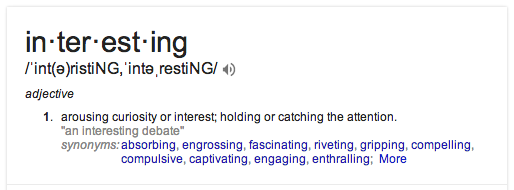I’ve been talking quite a bit lately with some marketing leaders about an interesting subject: social media engagement and sharing. So when I came across MarketingProfs’ data-intensive post about on the subject, “Why People Share on Social Media,” I was very interested.
I must say though, the findings of the study presented really were not all that interesting. The article reported the top reasons why people post on social media, led by:
- To share interesting things (61%)
- To share important things (43%)
- To share funny things (43%)
- To let others know what they believe in (39%)
- To recommend a product or service (30%)
Five more reasons followed, but I’m going to spare you the lower half of the list because I don’t want to lose you. I plan to get more interesting before too long.
The reasons I challenge the interest level of the report are (1) I think the top reason is unsurprising and (2) I think you could make a case that reasons 2, 3, 4, and 5 could be characterized as versions of reason 1, “share interesting things.”
Are you with me? Would you share content you thought to be uninteresting? I hope not.
If there is an interesting take-away here, it’s this: people are 2X more likely to share interesting things than content regarding your product. And the lesson? You need to make your content interesting.
What’s interesting?
Now that’s an interesting question. (My apologies if my story is beginning to sound like Abbot and Costello’s “Who’s on First” routine.)
As we work to solve for the answer it’s inevitable more questions will surface… Who’s to say what’s interesting? Don’t different people have different interests? Are there universally interesting themes? If there are, wouldn’t that suggest creating content on these themes would run the risk of being predictable and trite?
Hmph.
I believe the best we can do is attempt to gain better insights on how to find out what interests content consumers and toss around ideas for capturing your audience’s interest. Here goes.
The “interesting” discovery process
 So, you doing anything interesting this weekend? You’re going to a soccer tournament? You call that interesting? Soccer bores me. But that’s me. However much I avoid the sport, it’s the most popular one in the world. Clearly, soccer is interesting to millions, maybe billions, of people.
So, you doing anything interesting this weekend? You’re going to a soccer tournament? You call that interesting? Soccer bores me. But that’s me. However much I avoid the sport, it’s the most popular one in the world. Clearly, soccer is interesting to millions, maybe billions, of people.
Interesting is in the eyes of the beholder. Discover what interests your audience with these tactics.
- Ask them—Conduct surveys and interviews. Use your blog and email to solicit feedback from your readers. LinkedIn Groups are a major source of sentiments, questions and answers for any given subject.
- Examine the competition—Research what your competitors publish paying special attention to the keywords they use in their titles and on their sites. Also, tune into the volume of social shares various topics and content types generate.
- Look to the leaders—Identify which companies and individuals garner the most attention in your niche and form conclusions about how they’ve managed to engage a sizable tribe. Chances are their ascent to high levels of influence had much to do with their ability to understand the audience’s interests.
- Stay current— Subscribe to relevant newsletters and publications. Set up Google Alerts to deliver timely content to your inbox. Find relevant forums. Spend some time on Q&A sites Quora and Yahoo Answers to find what questions inspire the most interaction.
- Analyze your website and blog—Learn to use Google Analytics regularly to stay on top of which content attracts the most traffic and where the audience is coming from.
- Troll Amazon—Search for topical books on Amazon and deduce what’s hot based on reviews and book sales.
- Know what trends— Use Google Trends to search for what is trending.
- Understand blog popularity—Establish a short list of leading blogs in your market and keep a close eye on the posts that rank highest for social shares and commentary.
- Listen on social—There are an abundance of free and paid social media listening tools (find 50 of them here). I’ve mentioned some I rely on already. Commit time daily to peruse social networks and put the power of the #hashtag search to work on Twitter, Google+ and Facebook.
The “interesting” content creation process
So you’ve gathered some good ideas about what interests your prospects and customers. Your work is hardly done. Now you have to pour heavy helpings of interesting into the content.
How that’s done is far from easy to define, describe or teach. You’ll have to figure much of it out yourself by trial and error. I’ll give you what I’ve got along with some pointers I’ve dug up, many of them from “How to Be More Interesting (In 10 Simple Steps)” by popular blogger, illustrator and author Jessica Hagy.
(Note: Jessica’s post, published November, 2011 by Forbes, has been viewed 1.77 million times so far. People found it interesting.)
Her pointers are a rally cry for individualism and expression…
- Explore—Seek the fringes. Color outside the lines. Hagy writes, “The inside of the echo chamber is where all the boring people hang out.” There’s a whole lot of echoing bouncing around online. Try doing things differently.
- Be you—The things that make you you are what will make your content memorable and unique—if you reveal them.
- Leave your comfort zone—Experiment with new ideas. Strangeness is encouraged. The idea is you grow right along with the people you’re sharing your ideas with.
- Be courageous—Jessica says “grow a pair,” have contrary opinions, and this gem: “If you’re not courageous, you’re going to be hanging around the water cooler, talking about the guy who actually is.”
What else…?
- Share a scoop—Psst. Surprise your audience with some exclusive stuff you scoop up.
- Don’t write, rap—I don’t mean do the Snoop Dog. I mean drop the “I’m a news reporter” approach that stiffens up the work and just have a conversation with the reader.
HubSpot’s Corey Eridon took a nice swing at a similar lesson with “How Even Boring Industries Can Create Interesting Content.” Among the ideas you’ll want to check out in her piece are:
- Write with specificity—Good one. “The screen door slams. Mary’s dress waves.” Springsteen knows there’s beauty in the details, so he uses them to develop the characters and stories in his work.
- Use humor
- Use visuals
- Use interviews
I told you I’d give you what I’ve got and two resources come to mind. With tongue firmly in cheek, I crafted this short slide show.
 Also, if I’ve yet to persuade you to download my latest eBook, “Strike A Chord: Lessons for Making Your Web Content Resonate,” you’ll find a heap of ideas in it, which of course, I hope inspires you.
Also, if I’ve yet to persuade you to download my latest eBook, “Strike A Chord: Lessons for Making Your Web Content Resonate,” you’ll find a heap of ideas in it, which of course, I hope inspires you.
Finally, and ABOVE ALL…
Evoke feelings—This is the key to getting people to remember you and share your content. More to come on that. (A sequel’s in the works.)
If you find these ideas interesting, please share them. And, of course, if you have insight to add, your fellow readers will surely be interested in reading them.







